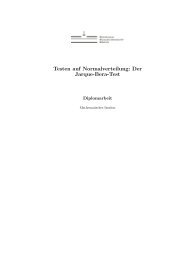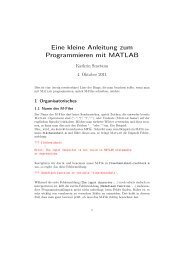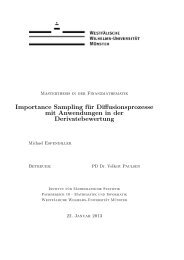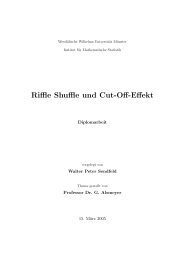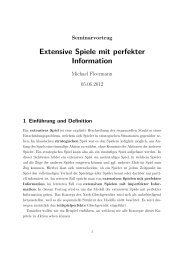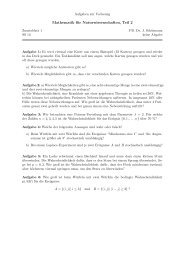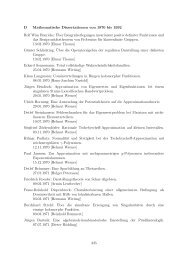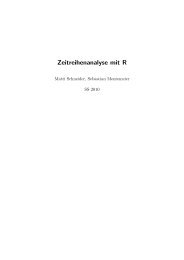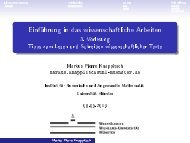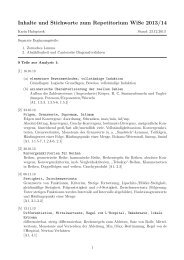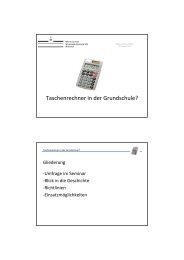Margulis Lemma
Margulis Lemma
Margulis Lemma
Create successful ePaper yourself
Turn your PDF publications into a flip-book with our unique Google optimized e-Paper software.
34 VITALI KAPOVITCH AND BURKHARD WILKING<br />
transformation group with nearly dense orbits, the result actually holds for all<br />
p ∈ ˜M i .<br />
In order to show that M i is aspherical we may replace M i by a bounded cover and<br />
thus, by Theorem 1 without loss of generality, π 1 (M i ) has a nilpotent basis of length<br />
≤ n. Because rank(π 1 (M i )) ≥ n it follows that π 1 (M i ) is torsion free. Therefore<br />
we can choose subgroups {e} = N i 0 ⊳ · · · ⊳ N i n = π 1 (M i ) with N i j /Ni j−1 ∼ = Z.<br />
In the rest of the proof we will slightly abuse notations and sometimes drop<br />
basepoints when talking about pointed Gromov–Hausdorff convergence when the<br />
base points are clear.<br />
Note that the above claim easily implies that ˜M i /N i j → Rn−j for all j = 0, . . . n.<br />
Claim 2. N i j ⋆ B r(˜p i ) is contractible in N i j ⋆ B 4 4j r (˜p i) for j = 1, · · · , n and r ∈<br />
[<br />
1, 4<br />
4 (2n−j)2 ] and all large i.<br />
We want to prove the statement by induction on j. For j = 0 it holds as was<br />
pointed out above. Suppose it holds for j < n and we need to prove it for j + 1.<br />
Choose g ∈ N i j+1 representing a generator of Ni j+1 /Ni j .<br />
Notice that N i j+1 ⋆ B R(˜p i )/N i j converges to R × B R(0) ⊂ R n−j as i → ∞ where<br />
B R (0) is the ball in R n−j−1 . Moreover, the action of N i j+1 /Ni j on the set converges<br />
to the R action on R × B R (0) given by translations.<br />
We can also find finite index subgroups ¯N i j+1 ⊂ Ni j+1 with Ni j ⊂ ¯N i j+1 such that<br />
N i j+1 ⋆ B R(˜p i )/¯N i j+1 converges to S1 × B R (0) ⊂ S 1 × R n−j where S 1 has diameter<br />
10 −n . It is easy to construct a smooth map ¯σ : N i j+1 ⋆ B R(˜p i )/¯N i j+1 → S1 that is<br />
arbitrary close to the projection map S 1 × B R (0) → S 1 in the Gromov–Hausdorff<br />
sense.<br />
We can lift ¯σ to a map σ : N i j+1 ⋆ B R(˜p i ) → R. Notice that σ commutes with the<br />
action of ¯N i j+1 where ¯N i j+1 /Ni j can be thought of as the deck transformation group<br />
of the covering R → S 1 .<br />
It suffices to show that N i j+1 ⋆ B r(˜p i ) → N i j+1 ⋆ B 4 4j+1 r (˜p i) induces the trivial<br />
map on the level of homotopy groups. Thus, we have to show that for any k > 0<br />
any map ι: S k → N i j+1 ⋆ B r(˜p i ) is null homotopic in N i j+1 ⋆ B 4 4j+1 r (˜p i).<br />
We can assume that ι is smooth. The image of σ ◦ ι is given by an interval<br />
[a, b] in R. We choose a 10 −n -fine finite subdivision a < t 1 < · · · < t h < b of the<br />
interval such that the t α are regular values. Thus ι −1 (σ −1 (t α )) = H α is a smooth<br />
hypersurface in S k for every α.<br />
Notice that by construction, the image ι(H α ) is contained in gN j ⋆ B 2r (˜p i ) for<br />
some g ∈ ¯N i j+1 . By induction assumption, ι |H α<br />
is homotopic to a point map in<br />
gN i j ⋆ B 4 4j 2r (˜p i). We homotope ι into ˜ι such that ˜ι(H α ) is a point for all α and ˜ι is<br />
4 4j 4r close to ι.<br />
Consider now all components of H α for all α. They divide the sphere into<br />
connected regions such that each boundary component of a region is mapped by ˜ι<br />
to a point and the whole region is mapped to a set gN i j ⋆ B 4 4j 8r (˜p i) for some g.<br />
Thus the map ˜ι restricted to a region with crushed boundary components is null<br />
homotopic in g ⋆B 4 2·4 j 8r (˜p i) by the induction assumption. Clearly, this implies that<br />
ι is null homotopic in N i j+1 ⋆ B 4 4j+1 r (˜p i).<br />
This finishes the proof of Claim 2. Notice that N i n ⋆ B 1 (˜p i ) = ˜M i for large i since<br />
diam(M i ) → 0. Thus ˜M i is contractible by Claim 2.<br />
□



